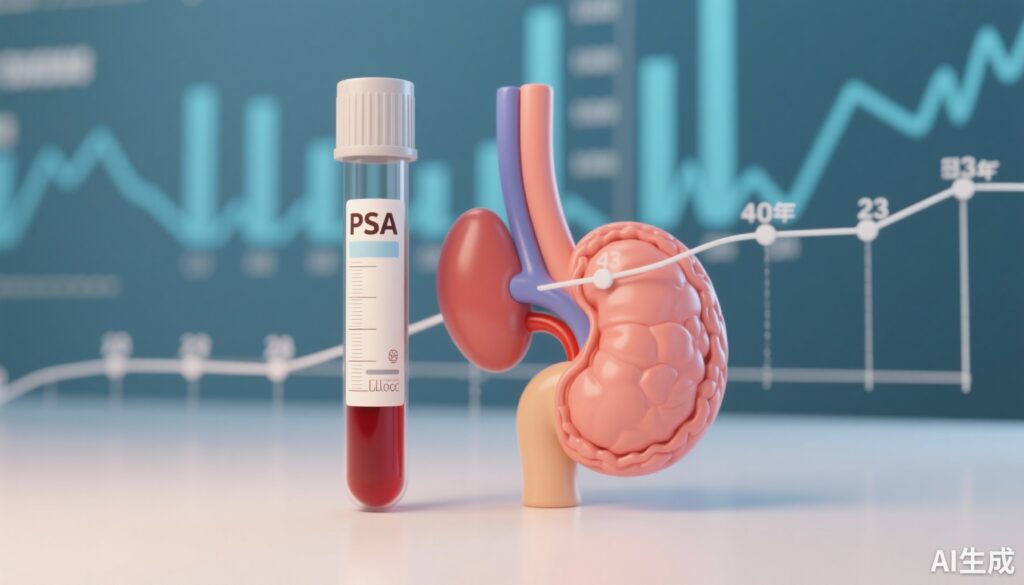Highlight
– PSA screening leads to a 13% reduction in prostate cancer mortality after 23 years.
– Absolute risk reduction is 0.22%, indicating a small but meaningful benefit.
– Screening increases prostate cancer diagnosis by 30%, reflecting overdiagnosis.
– One prostate cancer death is prevented for every 456 men invited to screening.
– Improved harm-benefit ratio suggests more targeted, risk-based screening is warranted.
Study Background
Prostate cancer remains one of the most commonly diagnosed cancers worldwide, with its incidence rising particularly due to increased life expectancy and demographic changes. Prostate-specific antigen (PSA) testing was introduced to detect prostate cancer earlier, aiming to reduce mortality. However, balancing benefits against potential harms such as overdiagnosis and overtreatment has been contentious. The European Randomized Study of Screening for Prostate Cancer (ERSPC) was launched in 1993 to rigorously assess the long-term effects of repeated PSA screening on prostate cancer mortality among men aged 55 to 69 years. The need for extended follow-up is critical given the often protracted natural history of prostate cancer and the potential delayed benefits of screening.
Study Design
ERSPC is a multicenter, randomized controlled trial across eight European countries, enrolling over 160,000 men aged 55 to 69 years at randomization. Participants were randomized into two groups: the screening arm, which received repeated PSA testing invitations, and the control arm, which was not invited to screening. The primary endpoint was prostate cancer–specific mortality, assessed after prolonged follow-up. Secondary evaluations included incidence rates, harms associated with screening such as overdiagnosis, and quantified benefits in terms of deaths prevented. The analysis focused on a core age group to standardize comparisons and optimize validity.
Key Findings
After a median of 23 years of follow-up, the ERSPC data demonstrate a sustained 13% reduction in prostate cancer mortality in the screened group compared to controls (rate ratio 0.87; 95% confidence interval [CI], 0.80 to 0.95). This translates to an absolute risk reduction of 0.22% (95% CI, 0.10 to 0.34). While the cumulative incidence of prostate cancer was 30% higher in the screening group (rate ratio 1.30; 95% CI, 1.26 to 1.33), this reflects overdiagnosis inherent to screening strategies. The number needed to screen (NNS) to prevent one prostate cancer death improved with longer follow-up: one death prevented per 456 men invited to screening (95% CI, 306 to 943), compared with one per 628 at 16 years. Correspondingly, one death from prostate cancer was averted for every 12 men diagnosed (95% CI, 8 to 26), improved from one per 18 diagnosed at 16 years.
These findings underscore the durable mortality benefit of PSA screening with an improved harm-benefit ratio over time. Notably, longer follow-up reduces the number of men needing screening or diagnosis to avert one prostate cancer death, suggesting that initial concerns about screening-related harms may be offset by eventual mortality benefits.
The increased detection of prostate cancer cases highlights overdiagnosis — the identification of cancers unlikely to cause symptoms or death during a man’s lifetime. Balancing early detection and avoiding unnecessary treatment remains a clinical challenge.
Expert Commentary
The ERSPC findings reinforce prior evidence supporting PSA screening’s role in reducing prostate cancer mortality. Importantly, the sustained benefit after two decades stresses the importance of long-term follow-up to fully capture screening effects. The modest absolute risk reduction and improved NNS ratios advocate for more nuanced, risk-adapted screening approaches rather than population-wide uniform strategies.
Several expert opinions highlight that while PSA screening is beneficial, its application should be tailored based on individual risk factors such as family history, baseline PSA levels, age, and comorbidities to minimize overdiagnosis and overtreatment. Incorporating biomarker improvements, imaging modalities like multiparametric MRI, and active surveillance protocols could refine patient selection and management.
Limitations of ERSPC include variability in screening intervals and preliminary uptake across centers, as well as the potential impact of treatment advances over time. Generalizability to non-European populations requires consideration of differing healthcare resources and epidemiology.
Conclusion
This comprehensive 23-year follow-up of the ERSPC trial provides robust evidence that repeated PSA screening significantly reduces prostate cancer mortality with a decreasing number needed to screen and diagnose over time, indicating improved harm-benefit balance. These data support the implementation of risk-based, individualized screening protocols to maximize clinical benefit while minimizing harms such as overdiagnosis. Future prostate cancer screening guidelines should emphasize personalized risk stratification and integration of novel diagnostic tools to optimize patient outcomes.
Funding and Trial Registration
The ERSPC trial was funded by the Dutch Cancer Society and other European research entities. It is registered at the ISRCTN registry under number ISRCTN49127736.
References
Roobol MJ, de Vos II, Månsson M, Godtman RA, Talala KM, den Hond E, Nelen V, Villers A, Poinas G, Kwiatkowski M, Wyler S, Recker F, Puliti D, Gorini G, Zappa M, Paez A, Lujan M, Bangma CH, Tammela T, Schröder FH, Remmers S, Hugosson J, Auvinen A; ERSPC Investigators. European Study of Prostate Cancer Screening – 23-Year Follow-up. N Engl J Med. 2025 Oct 30;393(17):1669-1680. doi: 10.1056/NEJMoa2503223. PMID: 41160819.



